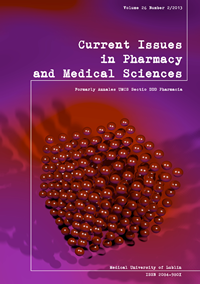Effects of various naturally occurring compounds (arbutin, borneol, esculetin, esculin, ellagic acid, gallic acid, hesperidine, piperitol, piperonal, quercetin, thymoquinone and ursolic acid) against maximal electroshock-induced seizures in mice
DOI:
https://doi.org/10.12923/j.2084-980X/26.2/a.03Słowa kluczowe:
arbutin, borneol, esculetinx, esculetin, esculin, ellagic acid, gallic acid, hesperidine, piperitol, piperonal, quercetin, thymoquinone, ursolic acid, maximal electroshock seizure testAbstrakt
The aim of this study was to perform the anticonvulsant screening test to select some naturally occurring substances isolated from herbs and medicinal plants that could offer a distinct protection against maximal electroshock (MES)-induced tonic seizures in mice. The screening test was performed for 12 substances (i.e., arbutin, borneol, esculetin, esculin, ellagic acid, gallic acid, hesperidine, piperitol, piperonal, quercetin, thymoquinone and ursolic acid) administered intraperitoneally in a constant dose of 300 mg/kg at various pretreatment times (i.e., 15, 30, 60 and 120 min.) before the MES test. Results indicate that only borneol produced a 75% protection against MES-induced tonic seizures in mice, when administered i.p. at 15 min. prior to the MES test. Borneol administered i.p. at 30 min before the MES test protected a 37.5% of animals tested, whereas the compound administered i.p. at 60 min. prior to the test exerted barely a 12.5% protection against MES-induced tonic seizures. In contrast, borneol administered i.p. at 120 min. prior to the test produced no anticonvulsant activity in mice subjected to the MES test. The remaining substances tested in the mouse MES model (i.e., arbutin, esculetin, esculin, ellagic acid, gallic acid, hesperidine, piperitol, piperonal, quercetin and ursolic acid) exerted no or negligible anti-seizure activity after their i.p. administration to mice. In conclusion, borneol is worthy of consideration as a potentially favorable compound in epileptology, if the results from this study could be extrapolated into clinical settings.
Bibliografia
1. Abelson P.H.: Medicine from plants. Science, 247, 513, 1990.
2. Blanco M.M. et al.: Neurobehavioral effect of essential oil of Cymbopogon citratus in mice. Phytomedicine, 16, 265, 2009.
3. Brodie M.J., Schachter S.C., (2001) Fast Facts. Epilepsy, second ed., Health Press, Oxford.
4. Heinrich M., Gibbons S.: Ethnopharmacology in drug discovery: an analysis of its role and potential contribution. J. Pharm. Pharmacol., 53, 425, 2001.
5. Heinrich M.: Ethnobotany and its role in drug development. Phytother. Res., 14, 479, 2000.
6. Heinrich M.: Ethnobotany and natural products: the search for new molecules, new treatments of old diseases or a better understanding of indigenous cultures? Curr. Top. Med. Chem., 3, 141, 2003.
7. Kwan P., Brodie M.J.: Early identification of refractory epilepsy. N. Engl. J. Med., 342, 314, 2000.
8. Kwan P., Brodie M.J.: Epilepsy after the first drug fails: substitution or addition? Seizure, 9, 464, 2000.
9. Liao W.P. et al.: Study of antiepileptic effect of extracts from Acorus tatarinowii Schott. Epilepsia, 46 (Suppl 1), 21, 2005.
10. Löscher W., Fassbender C.P., Nolting B.: The role of technical, biological and pharmacological factors in the laboratory evaluation of anticonvulsant drugs. II. Maximal electroshock seizure models. Epilepsy Res., 8, 79, 1991.
11. Łuszczki J.J. et al.: Anticonvulsant effects of four linear furanocoumarins, bergapten, imperatorin, oxypeucedanin, and xanthotoxin, in the mouse maximal electroshock-induced seizure model: a comparative study. Pharmacol. Rep., 62, 1231, 2010.
12. Łuszczki J.J., Głowniak K., Czuczwar S.J.: Imperatorin enhances the protective activity of conventional antiepileptic drugs against maximal electroshock-induced seizures in mice. Eur. J. Pharmacol., 574, 133, 2007.
13. Łuszczki J.J., Głowniak K., Czuczwar S.J.: Time-course and dose-response relationships of imperatorin in the mouse maximal electroshock seizure threshold model. Neurosci. Res., 59, 18, 2007.
14. Łuszczki J.J. et al.: Anticonvulsant and acute neurotoxic effects of imperatorin, osthole and valproate in the maximal electroshock seizure and chimney tests in mice: a comparative study. Epilepsy Res., 85, 293, 2009.
15. Łuszczki J.J. et al.: Influence of imperatorin on the anticonvulsant activity and acute adverse-effect profile of lamotrigine in maximal electroshock-induced seizures and chimney test in mice. Pharmacol. Rep., 60, 566, 2008.
16. Mandegary A. et al.: Anticonvulsant activity of the essential oil and methanolic extract of Bunium persicum (Boiss). B. Fedtsch. J. Ethnopharmacol., 140, 447, 2012.
17. Mandegary A. et al.: Anticonvulsant activity and toxicity of essential oil and methanolic extract of Zhumeria majdae Rech, a unique Iranian plant in mice. Neurochem. Res., 37, 2725, 2012.
18. Pourgholami M.H. et al.: Evaluation of the anticonvulsant activity of the essential oil of Eugenia caryophyllata in male mice. J. Ethnopharmacol., 64, 167, 1999.
19. Pourgholami M.H. et al.: The fruit essential oil of Pimpinella anisum exerts anticonvulsant effects in mice. J. Ethnopharmacol., 66, 211, 1999.
20. Raza M. et al.: Anticonvulsant activities of the FS-1 subfraction isolated from roots of Delphinium denudatum. Phytother. Res., 15, 426, 2001.
21. Sayyah M., Nadjafnia L., Kamalinejad M.: Anticonvulsant activity and chemical composition of Artemisia dracunculus L. essential oil. J. Ethnopharmacol., 94, 283, 2004.
22. Sayyah M., Valizadeh J., Kamalinejad M.: Anticonvulsant activity of the leaf essential oil of Laurus nobilis against pentylenetetrazole- and maximal electroshock-induced seizures. Phytomedicine, 9, 212, 2002.
23. Stables J.P., Kupferberg H.J. (1997). Chapter 16 - The NIH Anticonvulsant Drug Development (ADD) Program: preclinical anticonvulsant screening project. In: Molecular and cellular targets for anti-epileptic drugs. Avanzini G., Regesta G., Tanganelli P., Avoli M. (editors). London: John Libbey; p. 191.
24. Wahab A. et al.: Anticonvulsant activities of nutmeg oil of Myristica fragrans. Phytother. Res., 23, 153, 2009.
25. White H.S. et al.: (2002) Discovery and preclinical development of antiepileptic drugs. In: Antiepileptic drugs. 5th edn. Levy R.H., Mattson R.H., Meldrum B.S., Perucca E. (editors). Philadelphia: Lippincott Williams & Wilkins; p. 36.
Pobrania
Opublikowane
Numer
Dział
Licencja
Prawa autorskie (c) 2013 Autorzy

Praca jest udostępniana na licencji Creative Commons Attribution-NonCommercial-NoDerivatives 3.0 Unported License.


